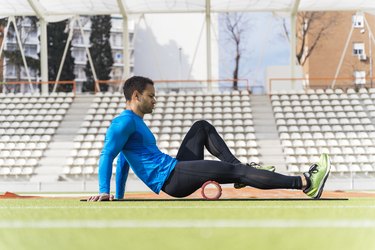

Ace one of the most effective exercises for a stronger lower body and work up to doing 150 reps in a single day with the 30-Day Squat Challenge. Get all the details on the challenge here.
You may have heard the saying, "You can't get the butt you want by sitting on the one you have." And while that's pretty much true, these three ways to build your booty may actually involve a bit of sitting down.
Related Reading
Video of the Day
1. Balance Your Macros
The maxim "abs are made in the kitchen," applies to your butt, too. If you're doing a lot of squats, deadlifts and glute bridges, working up a sweat and taxing your muscles, you need to fuel your body properly.
Video of the Day
While all macronutrients (carbs, fat and protein) play an important role in a solid nutrition plan, if a stronger backside is your primary goal, focus on upping your protein and fat intake.
Generally, the range you want to aim for is 45 to 65 percent carbohydrates, 20 to 35 percent fat and 10 to 35 percent protein, according to The Food and Nutrition Board of the Institutes of Medicine.). But those ranges leave a lot of wiggle room and every body is different, so you may need to play around with your ratio a bit.
That doesn't give you license to eat steaks and cheese all day, though (though some of us may want to!). Make sure your macros are coming from quality sources. For protein — which helps rebuild muscle — opt for eggs, chicken and salmon (or quinoa, lentils and almonds if you're following a plant-based or vegetarian diet). For fat, choose from avocados, olive oil, nuts and seeds.
2. Take Rest Days
Muscle isn't actually built in the gym or during your workouts. It's built when you're resting between your workouts.
"Rest is important for two reasons," says Ben Lauder Dykes, Fhitting Room instructor and 30-Day Squat Challenge host. "One is that rest helps us recover from fatigue, so that when we work out again, we can train at a high level. The other reason is that we need time for our bodies to go through the recovery stage to see adaptations."
When you exercise, you're causing micro-tears in your muscle fibers (which is partly why you might feel sore the next day). Your body repairs these tears and your muscles get stronger in the process, but if you don't take rest days, your muscles never get the chance to fully recover, so your gains will plateau and you run the risk of overtraining.
Consider this your permission to take it easy every once in a while.
3. Stretch and Foam Roll
If you really can't sit still on your off days, make it an active-recovery day by doing some stretches and foam rolling.
"The best stretches to do after squats would be a pigeon stretch for the glutes and hips and a quad stretch, which can be performed either lying or standing," Lauder-Dykes says.
Related Reading
1. Pigeon Stretch
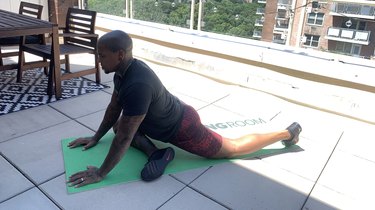
- Start kneeling, then extend your left leg straight behind you. Your right leg should be bent in front of you, with the shin perpendicular to your torso.
- Sink into the stretch as much as your flexibility will allow.
- Hold for 30 seconds before switching legs.
Tip
Fold your torso over your front leg for a deeper stretch.
2. Seated Spinal Twist
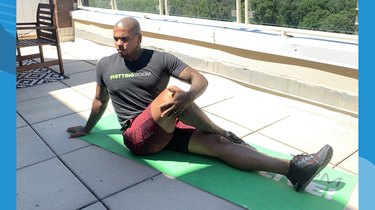
- Begin seated with your legs extended straight out in front of you.
- Bend your right knee and cross that foot to the outside of your left knee.
- Twist to the right and hook your left elbow over your right knee to assist with the twist. Only twist as far as is comfortable.
- Hold for 30 seconds before switching sides.
3. Deep Lunge
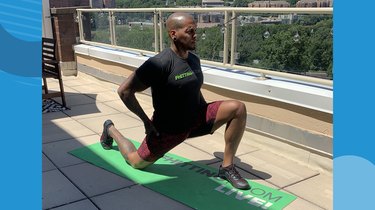
- From standing, step forward so that your right foot is a few feet in front of your left.
- Bend your right knee to a 90-degree angle.
- Drop your left knee to the floor (place a folded towel or blanket underneath for extra padding).
- Place your hands on your hips, and push your hips forward until you feel a stretch.
- Hold for 30 seconds before switching sides.
4. Thread the Needle
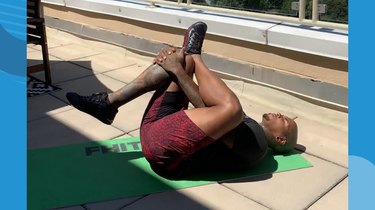
- Lie on your back on the floor with both knees bent and feet planted flat.
- Pick your right leg up and cross your ankle over the knee of the other leg.
- Take your right arm and slide it through the space between your right and left leg. Grab the front of your left knee with that hand.
- Reach around your left leg with your left hand and grab the front of the left knee.
- Slowly lean your upper body back and pull your left knee in toward your chest. You should feel this stretch along the side of your right leg and in your right glute.
- Hold for 30 seconds and repeat on the other side.
5. Foam Rolling
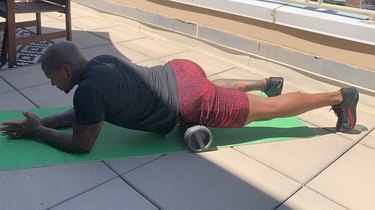
- Grab a foam roller, lie on your stomach and place the roller underneath one of your quads.
- While supporting yourself on your forearms (kind of like a plank), roll yourself back and forth, starting at the hip crease and moving down toward your knee (don't roll over your knee).
- As you make your way down, stop and give extra attention to any spot that feels tight.
- Repeat on the other leg.
- Next, sit down with your legs straight out in front of you and place the roller under your hamstrings.
- Support your weight on your hands with your arms behind your back.
- Roll forward so the foam roller is under your butt.
- Whenever you feel a particularly tight spot, stay on it for no more than 20 seconds or make small rolling motions back and forth to massage the area.
- You can also lean slightly to the side and roll out each side of your glutes and hips.
Tip
"Foam rolling can be a useful tool to help increase blood flow, oxygen and nutrients to the muscles to support the recovery process," Lauder-Dykes says. "Be sure to also target the calves to maintain the ability to create flexion to get to the lower ranges of the squat."
Was this article helpful?
150 Characters Max
0/150
Thank you for sharing!
Thank you for your feedback!